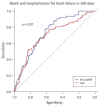Prognostic impact of chromogranin A in patients with acute heart failure
- PMID: 34233402
- PMCID: PMC8688787
- DOI: 10.12701/yujm.2020.00843
Prognostic impact of chromogranin A in patients with acute heart failure
Abstract
Backgruound: Chromogranin A (CgA) levels have been reported to predict mortality in patients with heart failure. However, information on the prognostic value and clinical availability of CgA is limited. We compared the prognostic value of CgA to that of previously proven natriuretic peptide biomarkers in patients with acute heart failure.
Methods: We retrospectively evaluated 272 patients (mean age, 68.5±15.6 years; 62.9% male) who underwent CgA test in the acute stage of heart failure hospitalization between June 2017 and June 2018. The median follow-up period was 348 days. Prognosis was assessed using the composite events of 1-year death and heart failure hospitalization.
Results: In-hospital mortality rate during index admission was 7.0% (n=19). During the 1-year follow-up, a composite event rate was observed in 12.1% (n=33) of the patients. The areas under the receiver-operating characteristic curves for predicting 1-year adverse events were 0.737 and 0.697 for N-terminal pro-B-type natriuretic peptide (NT-proBNP) and CgA, respectively. During follow-up, patients with high CgA levels (>158 pmol/L) had worse outcomes than those with low CgA levels (≤158 pmol/L) (85.2% vs. 58.6%, p<0.001). When stratifying the patients into four subgroups based on CgA and NT-proBNP levels, patients with high NT-proBNP and high CgA had the worst outcome. CgA had an incremental prognostic value when added to the combination of NT-proBNP and clinically relevant risk factors.
Conclusion: The prognostic power of CgA was comparable to that of NT-proBNP in patients with acute heart failure. The combination of CgA and NT-proBNP can improve prognosis prediction in these patients.
Keywords: Biomarkers; Chromogranin A; Heart failure; Prognosis.
Conflict of interest statement
No potential conflict of interest relevant to this article was reported.
Figures



Similar articles
-
Chromogranin A and C-terminal endothelin-1 precursor fragment add independent prognostic information to amino-terminal proBNP in patients with acute destabilized heart failure.Clin Chim Acta. 2009 Feb;400(1-2):91-6. doi: 10.1016/j.cca.2008.10.012. Epub 2008 Oct 29. Clin Chim Acta. 2009. PMID: 19000665
-
Combining the use of amino-terminal pro-B-type natriuretic peptide and B-type natriuretic peptide in the prognosis of hospitalized heart failure patients.Clin Chim Acta. 2019 Apr;491:8-14. doi: 10.1016/j.cca.2018.12.025. Epub 2018 Dec 28. Clin Chim Acta. 2019. PMID: 30594544
-
[Predictive value of admission amino-terminal pro-B-type natriuretic peptide on in-hospital mortality in patients with decompensated heart failure].Zhonghua Xin Xue Guan Bing Za Zhi. 2009 Jun;37(6):481-5. Zhonghua Xin Xue Guan Bing Za Zhi. 2009. PMID: 19927625 Chinese.
-
The predictive value of plasma biomarkers in discharged heart failure patients: role of plasma NT-proBNP.Minerva Cardioangiol. 2016 Apr;64(2):157-64. Epub 2015 Sep 15. Minerva Cardioangiol. 2016. PMID: 26373781 Review.
-
Chromogranin A and Its Fragments in the Critically Ill: An Expanding Domain of Interest for Better Care.Pharmaceutics. 2022 Oct 12;14(10):2178. doi: 10.3390/pharmaceutics14102178. Pharmaceutics. 2022. PMID: 36297613 Free PMC article. Review.
Cited by
-
Novel Biomarkers of Renal Dysfunction and Congestion in Heart Failure.J Pers Med. 2022 May 29;12(6):898. doi: 10.3390/jpm12060898. J Pers Med. 2022. PMID: 35743683 Free PMC article. Review.
-
The Role of Congestion Biomarkers in Heart Failure with Reduced Ejection Fraction.J Clin Med. 2023 Jun 3;12(11):3834. doi: 10.3390/jcm12113834. J Clin Med. 2023. PMID: 37298029 Free PMC article. Review.
References
-
- Benjamin EJ, Muntner P, Alonso A, Bittencourt MS, Callaway CW, Carson AP, et al. Heart Disease and Stroke Statistics-2019 Update: A Report From the American Heart Association. Circulation. 2019;139:e56–528. - PubMed
Grants and funding
LinkOut - more resources
Full Text Sources
Research Materials

